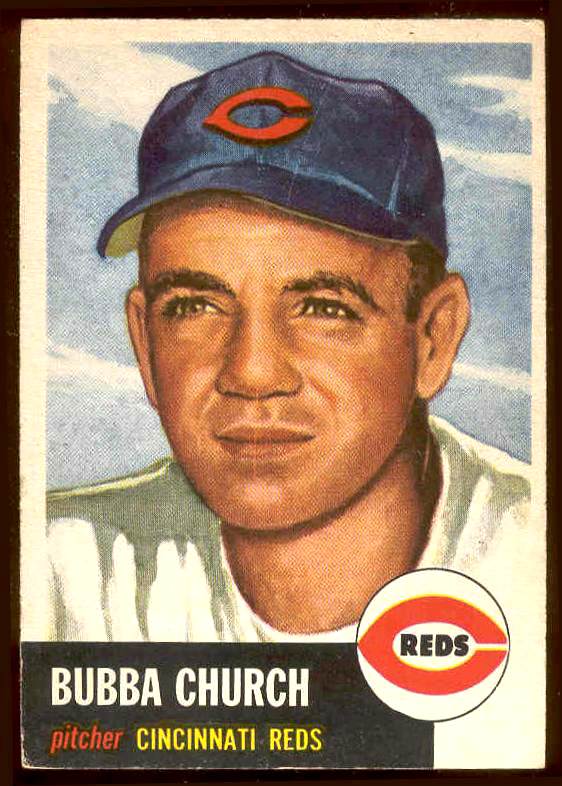Below are short bits & pieces on sportscard & baseball trading card collecting.
Please wander around the website for more info, prices, values & images
on vintage baseball, football, basketball, hockey, sport and non-sports cards.

1955 Topps Double-Headers (Doubleheaders)
Baseball Cards Set checklist/info


Without a doubt my FAVORITE SET - PERIOD. Regular issue, test issues,
inserts ... whatever ... this is # 1 !!!
Similar to the early 1900's Mecca Double Folders, these colorful
2-1/16" x 4-7/8" cards are actually 2-cards-in-1 !
Perforated in the center, you can fold to create cards of 2
different players. Unperforated 1955 Topps DoubleHeaders exist.
 All 132 players (66 cards) in the 1955 Topps DoubleHeaders set were also in
the regular 1955 Topps set, with the same action image.
All 132 players (66 cards) in the 1955 Topps DoubleHeaders set were also in
the regular 1955 Topps set, with the same action image.
 NOTE: Laid side-by-side the cards form spectacular scenes
from actual stadiums !!!
NOTE: Laid side-by-side the cards form spectacular scenes
from actual stadiums !!!
Old-timers - can you identify the stadiums ?
ROOKIES:
Harmon Killebrew, Hal Newhouser
STARS:
Ted Williams, Hank Aaron, Jackie Robinson ...
The Best !!!
Click for complete
1955 Topps Double-Headers (Doubleheaders) baseball cards Checklist and Prices
Note: You may be on that page right now.
|

1951 Bowman Baseball
Cards Checklist & Values
1951 was Bowman's largest set to date, both in the card size and
number of cards. Thanks to the several major rookies, led by Mickey Mantle
and Willie Mays, the 1951 Bowman set is by far Bowman's most valuable.
Bowman again used hand-painted color reproductions of actual photographs.
The 1951 Bowman card fronts were very similar to the 1950 set, with several
players 1951 Bowman cards look like larger versions of their 1950 card.
Cards #243-#324 are scarce high numbers. The rookie cards of Mickey Mantle
and Willie Mays are in this series making them very difficult to obtain.
TOP ROOKIES: Mickey Mantle, Willie Mays, Whitey Ford, Monte Irvin, Nellie Fox,
Joe Garagiola, Jackie Jensen, Jim Piersall ...
TOP STARS: Ted Williams, Yogi Berra, Roy Campanella, Pee Wee Reese, Bob Feller,
Warren Spahn, Duke Snider, Richie Ashburn & MORE !!!
Note: You may be on that page right now.
|

1952,1953,1954,1955 Red Man TOBACCO
Checklist & Values
Tobacco cards were instrumental in the start of the baseball card industry
but were pretty much unheard of since 1920. That is until RED MAN TOBACCO
got in the game issuing baseball cards in 1952, 1953, 1954 & 1955.
For just 20 cents you got a pouch of Red Man tobacco and one awesome
3-1/2 x 4 inch baseball card with it's tab (3-1/2 x 3-5/8 without).
Exchange FIFTY tabs and you got one free big league style felt
baseball cap of your favorite team. This made cards with tabs much,
much harder to find and values 2 to 10 times higher.
25 players from each league were selected by "Sporting News" editor
J.G. Taylor Spink. A Player's artwork with different backgrounds
was used year after year. If a player changed teams, new team name
& logo were painted over the old one. To determine the year, just
subtract 1 from the expiration date on back of the card.
The 1954 set had four variations.
Click for complete
1952,1953,1954,1955 Red Man Tobacco cards checklist & prices
Note: You may be on that page.
|

Tobacco Cards
Starting approximately in 1886, sportscards, mostly baseball cards, were often
included with tobacco products, for promotional purposes and also because the
card reinforced the packaging and protected cigarettes from damage. These sports
cards are referred to as tobacco cards in the baseball card hobby. Over the next
few years many different companies produced baseball cards. Tobacco cards soon
started to disappear as the American Tobacco Company tried to develop a monopoly
by buying out other companies.
They were reintroduced in the 1900s, as American Tobacco came under pressure from
antitrust action and Turkish competition. The most famous and most expensive,
baseball card is the rare T206 Honus Wagner. The card exists in very limited
quantities compared to others of its type because Wagner forced the card to be
removed from printing. It is widely (and incorrectly) believed that Wagner did
so because he refused to promote tobacco, but the true explanation lies in a
dispute over compensation.
Soon other companies also began producing baseball and football cards. Sports magazines
such as The Sporting News were early entries to the market. Candy manufacturers
soon joined the fray and reflected a shift toward a younger target audience for cards.
Caramel companies were particularly active and baseball cards were one of the first
prizes to be included in Cracker Jacks. World War I soon suppressed baseball card
production.
© 1995-2019 "InterNet's Baseball Card Store" / Joseph Juhasz ... All Rights Reserved
|








